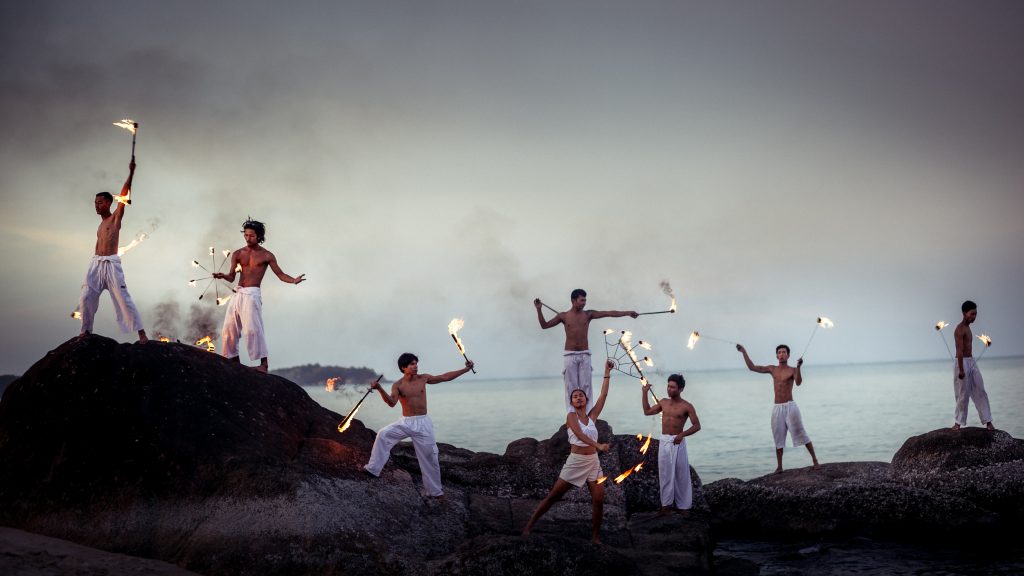Definition Flow Art
” The information in this post comes from discussions with fire artists in Thailand and some of the original flow artists who traveled, learned, and contributed to the creation and growth of fire art as a global practice. I have worked on defining flow art based on these insights. The artists at Samui Circus generously shared much of this history and knowledge with me. Through this post, I aim to gather their wisdom, allowing others to learn about the practice’s history in Thailand and the meanings and benefits people draw from it.”
Contributors :
Dr. Tiffany Pollock, a researcher based in Canada, explores how performers use dance, music, and arts as forms of activism, identity creation, and platforms to navigate the complexities of their lived experiences. She focuses on how communities form through specific arts practices and how belonging, inclusion, and exclusion are created and contested. Her research includes diverse art forms such as fire art, salsa dance, throat singing, and hip-hop, among others.
Definition Flow Art :
Flow art revolves around finding a rhythmic “flow” with various pieces of equipment. Furthermore, it draws inspiration from culturally specific art forms, including Maori poi traditions and Hawai’ian Hula dance. In the 1980s, young backpackers learned these practices during their travels and then shared them with others. Consequently, pinpointing exactly how these forms blended into what we now call flow art remains challenging. Over time, flow art evolved into different branches, such as fire art—a dynamic performance style that has spread worldwide. Additionally, it shares deep connections with circus arts and juggling, a tradition dating back to ancient Egypt.
Fire Dance :
On the islands, performers often incorporate fire into their acts, creating mesmerizing visual effects. As they dance and move with equipment like poi, hoops, fans, chains, and staffs, they bring performances to life with dazzling patterns of light and motion. Moreover, many fire artists excel in juggling and entertainment. In addition to fire spinning, they often practice other disciplines, including tightrope walking and acrobatics, which they seamlessly integrate into their elaborate shows.
Benefits of Flow Art :
The most important thing to know about flow art is that anyone can learn and enjoy it. Beyond entertainment, it offers several benefits, such as increased concentration, improved coordination, making new friends, greater body awareness, the joy of moving to music, and the experience of “flow.” Flow art gets its name from the concept of “flow,” introduced by psychologist Mihaly Csikszentmihalyi in his book Flow: The Psychology of Optimal Experience (1990). According to Csikszentmihalyi, “flow” is a highly focused state where individuals become fully absorbed in an activity. He believed that reaching this state enhances happiness and fulfillment. Due to the intense focus required for flow art, artists regularly experience this state of deep concentration and enjoyment. Many fire artists describe the practice as meditative, helping them center their minds and find a sense of calmness, much like traditional meditation..
Flow Art in Thailand :
Flow art developed as a community practice in Thailand, growing as artists shared their knowledge. One key location in its history is Santichaiprakan Park in Bangkok, which became a hub for artists to gather and refine their craft. Over time, this community dispersed, yet its influence remains strong.Read more about the History of Fire Art in Thailand Here.
Samui Circus continues to serve as a creative hub where artists can grow, learn, and share their passion. It welcomes beginners, students, teachers, and advanced artists from around the world. Fostering a global community dedicated to the beauty and benefits of flow art.

Great content! Super high-quality! Keep it up! 🙂
Thank you so much 🙏🙏🙏
Do you have any? Kindly let me realize so that I may just subscribe.
Hello Elene, what are you looking for? 🙂
Hey there. I found your blog via Google even as looking for a similar subject, your website got here up. It seems great. I’ve bookmarked it in my google bookmarks to visit then.
Excellent site. Plenty of useful information here. I am sending it to a few friends ans also sharing in delicious. And obviously, thank you on your effort!
We are happy to see that you enjoy our website 🙏🙏🙏
A round of applause for your blog article.Really looking forward to read more. Really Cool.
any interesting article like yours. It is pretty
Appreciate you sharing, great article.Thanks Again. Really Great.
I’ve been absent for a while, but now I remember why I used to love this website. Thanks , I¡¦ll try and check back more frequently. How frequently you update your website?
Awesome post. I’m a regular visitor of your web site and appreciate you taking the time to maintain the nice site. I’ll be a regular visitor for a really long time.
On how she landed on her direction in life:
Hey there. I discovered your blog by the use of Google even as looking for a comparable topic, your web site got here up. It seems to be good. I have bookmarked it in my google bookmarks to come back then.
I simply want to mention I am just very new to blogging and definitely loved your web-site. Likely I’m want to bookmark your blog post . You absolutely have incredible posts. Thanks for sharing your blog site.
Thanks for the post.Really thank you! Great.